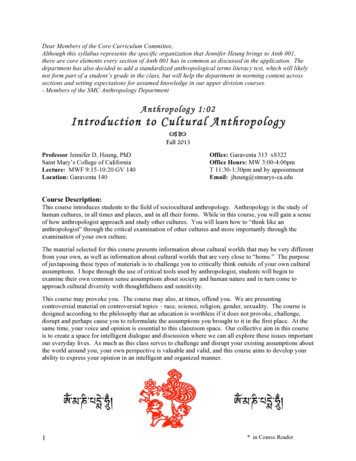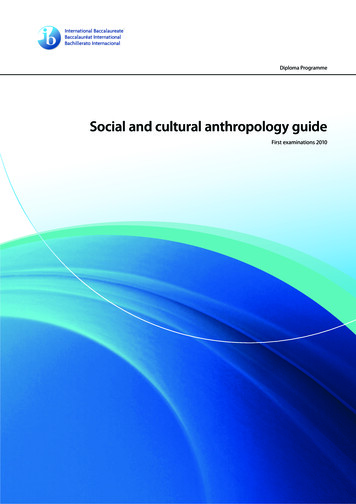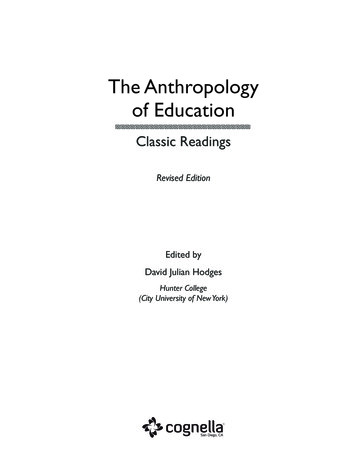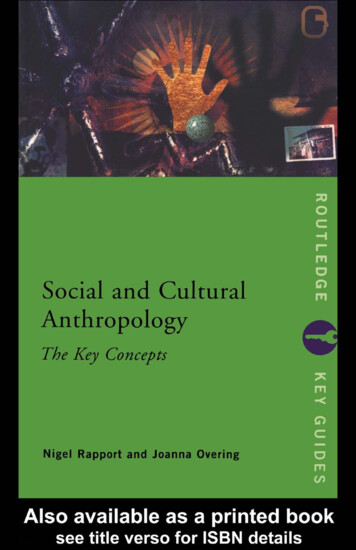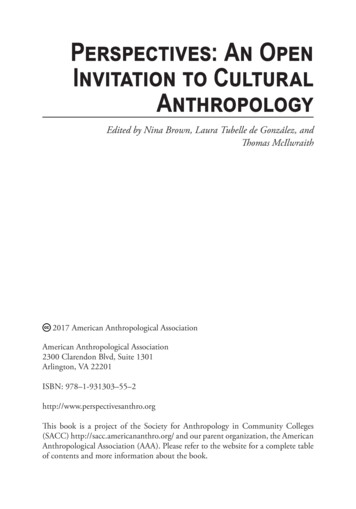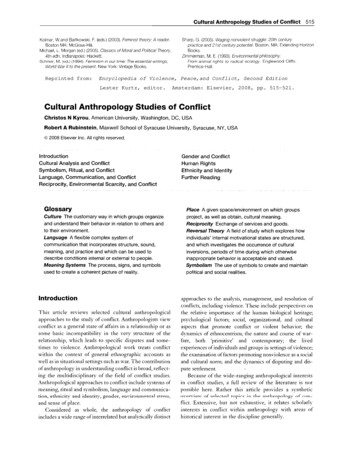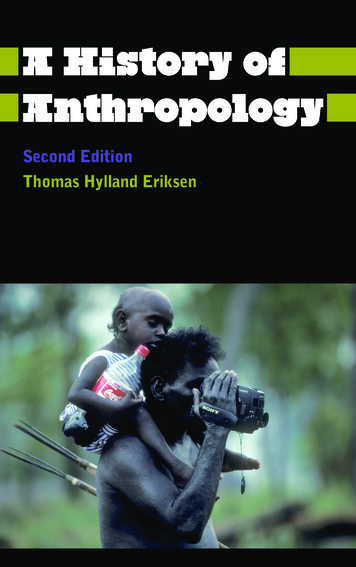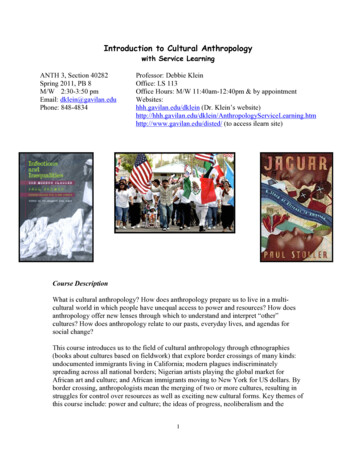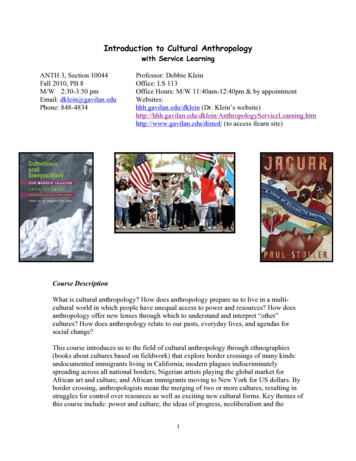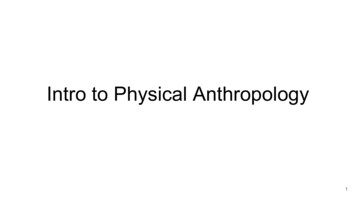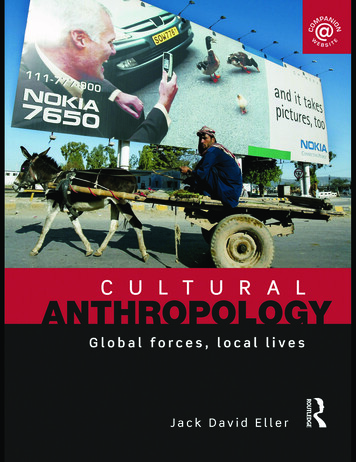
Transcription
Cultural AnthropologyCultural Anthropology: Global Forces, Local Lives is an accessible, ethnographically rich,cultural anthropology textbook which gives a coherent and refreshingly new visionof the discipline and its subject matter – human diversity. The fifteen chapters andthree extended case studies present all of the necessary areas of cultural anthropology,organizing them in conceptually and thematically meaningful and original ways.A full one-third of its content is dedicated to important global and historicalcultural phenomena such as colonialism, nationalism, ethnicity and ethnic conflict,economic development, environmental issues, cultural revival, fundamentalism, andpopular culture. The more conventional topics of anthropology (language, economics, kinship, politics, religion, race) are integrated into this broader discussion toreflect the changing content of contemporary courses.This well-written and well-organised text has been trialed both in the classroomand online. The author has extensive teaching experience and is especially good atpresenting material clearly matching his exposition to the pace of students’ understanding. Specially designed in colour to be useful to today’s students, CulturalAnthropology: Global Forces, Local Lives: supports study with chapter case studies on subjects as diverse as “Doinganthropology at Microsoft” and “Banning religious symbols in France”explains difficult key terms with marginal glosses and links related topics withmarginal cross-referencesassists revision with boxed chapter summaries, an extensive bibliography andindexillustrates concepts and commentary with a vivid range of photographs drawnfrom the most contemporary anthropological sourcesprovides a support website which includes study guides; Powerpoint presentations; chapter supplements; multiple-choice, essay, and assignment questions;a model course mapped to the textbook; a flashcard glossary of terms; and linksto useful maps.Jack David Eller is Assistant Professor of Anthropology at the Community Collegeof Denver. He is the author of Introducing Anthropology of Religion (Routledge 2007).
CulturalAnthropologyGlobal Forces, Local LivesJACK DAVID ELLER
First published 2009by Routledge270 Madison Ave, New York, NY 10016Simultaneously published in the UKby Routledge2 Park Square, Milton Park, Abingdon, Oxon OX14 4RNRoutledge is an imprint of the Taylor & Francis Group, an informa businessThis edition published in the Taylor & Francis e-Library, 2009.To purchase your own copy of this or any of Taylor & Francis or Routledge’scollection of thousands of eBooks please go to www.eBookstore.tandf.co.uk. 2009 Jack David EllerAll rights reserved. No part of this book may be reprinted or reproducedor utilised in any form or by any electronic, mechanical, or other means,now known or hereafter invented, including photocopying and recording,or in any information storage or retrieval system, without permission inwriting from the publishers.British Library Cataloguing in Publication DataA catalogue record for this book is available from the British LibraryLibrary of Congress Cataloging-in-Publication DataEller, Jack David, 1959–Cultural anthropology : global forces, local lives / Jack David Eller.p. cm.1. Ethnology. I. Title.GN316.E445 2009306—dc222008048585ISBN 0-203-87561-3 Master e-book ISBNISBN10: 0–415–48538–X (hbk)ISBN10: 0–415–48539–8 (pbk)ISBN10: 0–203–87561–3 (ebk)ISBN13: 978–0–415–48538–8 (hbk)ISBN13: 978–0–415–48539–5 (pbk)ISBN13: 978–0–203–87561–2 (ebk)
ContentsList of illustrationsList of boxesIntroductionCHAPTER 1 UNDERSTANDING ANTHROPOLOGYxixivxvi1THE SCIENCE(S) OF ANTHROPOLOGY 2TRADITIONAL ANTHROPOLOGY AND BEYOND 7THE “ANTHROPOLOGICAL PERSPECTIVE” 12THE RELEVANCE OF ANTHROPOLOGY 19SUMMARY 22CHAPTER 2 UNDERSTANDING AND STUDYING CULTUREDEFINING CULTURE 25THE BIOCULTURAL BASIS OF HUMAN BEHAVIOR 35STUDYING CULTURE: METHOD IN CULTURALANTHROPOLOGY 41SUMMARY 4924
viCONTENTSCHAPTER 3 THE ORIGINS OF CULTURAL ANTHROPOLOGY50WHAT MAKES CULTURAL ANTHROPOLOGY POSSIBLE –AND NECESSARY 51ENCOUNTERING THE OTHER 55RETHINKING SOCIETY: SEVENTEENTH- ANDEIGHTEENTH-CENTURY SOCIAL THEORY 59TOWARD AN ETHNOLOGICAL SCIENCE IN THENINETEENTH CENTURY 61THE TWENTIETH CENTURY AND THE FOUNDING OFMODERN ANTHROPOLOGY 62THE ANTHROPOLOGICAL CRISIS OF THE MID-TWENTIETHCENTURY AND BEYOND 67SUMMARY 71CHAPTER 4 LANGUAGE AND SOCIAL RELATIONS73HUMAN LANGUAGE AS A COMMUNICATION SYSTEM 75THE STRUCTURE OF LANGUAGE 77MAKING SOCIETY THROUGH LANGUAGE: LANGUAGE ANDTHE CONSTRUCTION OF SOCIAL REALITY 84LANGUAGE ACQUISITION AND THE LINGUISTICRELATIVITY HYPOTHESIS 92SUMMARY 96CHAPTER 5 LEARNING TO BE AN INDIVIDUAL: PERSONALITYAND GENDER98CULTURES AND PERSONS, OR CULTURAL PERSONS 99GENDER AND PERSON, OR GENDERED PERSONS 108SUMMARY 119CHAPTER 6 INDIVIDUALS AND IDENTITIES: RACE ANDETHNICITYTHE ANTHROPOLOGY OF RACE 122THE MODERN ANTHROPOLOGICAL CRITIQUE OF RACE 128121
CONTENTSviiTHE ANTHROPOLOGY OF ETHNICITY 132RACIAL AND ETHNIC GROUPS AND RELATIONS INCROSS-CULTURAL PERSPECTIVE 137SUMMARY 147Seeing Culture as a Whole #1: The Relativism ofMotherhood, Personhood, Race, and Health in a BrazilianCommunityCHAPTER 7 ECONOMICS: HUMANS, NATURE, AND SOCIALORGANIZATION148150ECONOMICS AS THE BASE OR CORE OF CULTURE 151THE ANTHROPOLOGY OF ECONOMICS 153SUMMARY 177CHAPTER 8 KINSHIP AND NON-KIN ORGANIZATION: CREATINGSOCIAL GROUPS179CORPORATE GROUPS: THE FUNDAMENTAL STRUCTURE OFHUMAN SOCIETIES 180KINSHIP-BASED CORPORATE GROUPS 181NON-KINSHIP-BASED CORPORATE GROUPS 198SUMMARY 205CHAPTER 9 POLITICS: SOCIAL ORDER AND SOCIAL CONTROLSOCIAL CONTROL: THE FUNCTIONS OF POLITICS 208POWER 212THE ANTHROPOLOGY OF POLITICAL SYSTEMS 216MAINTAINING INTERNAL ORDER AND “SOCIALHARMONY” 229AN ANTHROPOLOGY OF WAR 232SUMMARY 234207
viiiCONTENTSCHAPTER 10 RELIGION: INTERACTING WITH THE NON-HUMANWORLD236THE PROBLEM OF STUDYING RELIGIONANTHROPOLOGICALLY 237THE ELEMENTS OF RELIGION: SUPERHUMAN ENTITIESAND HUMAN SPECIALISTS 242THE ELEMENTS OF RELIGION: SYMBOL, RITUAL, ANDLANGUAGE 255SUMMARY 262Seeing Culture as a Whole #2: The Integration of Culture inWarlpiri SocietyCHAPTER 11 CULTURAL DYNAMICS: CONTINUITY AND CHANGE264267THE TRADITION OF TRADITION 268CULTURAL DYNAMICS: THE PROCESSES OF CULTURALCHANGE 272SUMMARY 288CHAPTER 12 COLONIALISM AND THE ORIGIN OFGLOBALIZATION290THE CULTURE OF COLONIALISM 292THE LEGACY OF COLONIALISM 303SUMMARY 312CHAPTER 13 THE STRUGGLE FOR POLITICAL IDENTITY:NATIONALISM, ETHNICITY, AND CONFLICTPOLITICS, IDENTITY, AND POST-COLONIALISM 316FLUID, FRAGMENTED, AND FRACTIOUS CULTURES INTHE MODERN WORLD 326FROM CULTURE TO COMPETITION TO CONFLICT 330SUMMARY 336314
CONTENTSixCHAPTER 14 THE STRUGGLE FOR ECONOMIC INDEPENDENCE:DEVELOPMENT, MODERNIZATION, ANDGLOBALIZATION338WHY ECONOMIC DEPENDENCE? 339THE PATH TO UNDERDEVELOPMENT 341DEVELOPMENT: SOLUTION AND PROBLEM 349MODELS OF DEVELOPMENT 356THE BENEFITS – AND COSTS – OF DEVELOPMENT 358SUMMARY 361CHAPTER 15 THE STRUGGLE FOR CULTURAL SURVIVAL, REVIVAL,AND REVITALIZATION363VOICES FROM ANOTHER WORLD 365FROM CULTURE TO CULTURAL MOVEMENT 369THE FUTURE OF CULTURE, AND THE CULTURE OF THEFUTURE 377SUMMARY 387Seeing Culture as a Whole #3: Exile, Refuge, and Culture389GlossaryBibliographyIndex391411423
Illustrations .14.24.35.15.25.36.16.26.37.1Teotihuacan near Mexico CityWarlpiri women preparing ritual objectsThe author in front of the Besaki Temple in Bali, 1988Australian Aboriginal artworksHominid fossil skulls: Australopithecus afarensis, Homo erectus,NeandertalBronislaw Malinowski conducting fieldwork with Trobriand Islanders London School of EconomicsBlemmyae British Library Board. All rights reserved. BL ref:1023910.691Franz Boas around 1895 Smithsonian National Museum of NaturalHistoryLinguistic anthropologists, late 1800s Smithsonian NationalMuseum of Natural HistoryPolitical speaking: Barack ObamaHerbert Jim Josh Mullenite jmullenite@gmail.comWarlpiri elder men showing boys sacred knowledge and skillsMuslim women in “purdah”Hijras in India Philip Baird/www.anthroarcheart.orgChildren in Central Australian Aboriginal societiesHuman faces of many races Ben van den Bussche,AmsterdamRacial divisions, racial tensions, and racial violence in apartheid SouthAfrica Getty ImagesKoya hunter from central India Sathya Mohan517213141485463748689101112117124138141156
xiiILLUSTRATIONS7.2 Tuareg pastoralist with his camels, North Africa Alberto Arzoz/ThePeoples of the World Foundation7.3 Hillsides cut into terraces in Nepal7.4 Market in downtown Tokyo8.1 Two mothers and their children from the Samantha tribe, India Sathya Mohan8.2 Traditional wedding ceremony on the island of Vanuatu8.3 Mexican girls celebrating their quinceañera Victoria Adame8.4 Members of the moran or warrior age-set among the Samburu ofKenya Barry Kass9.1 A mara’acame of the Huichol Indians Adrian Mealand9.2 The king or Asantehene of the Ashanti Kingdom SmithsonianNational Museum of Natural History9.3 Silvio Berlusconi, May 2008 Franco Origlia/Getty Images10.1 Golden Buddha in Thailand10.2 Warlpiri women lead girls in a dance ritual10.3 Inside of a spirit-house in Papua New Guinea11.1 Concrete houses built for the formerly nomadic Warlpiri11.2 Native American children at the Carlisle School boarding school Smithsonian National Museum of Natural History11.3 Newspaper protesting political oppression in Mongolia ChrisKaplonski12.1 British officer in colonial India. Digitization and enhancement VictorGodoirum Bassanensis12.2 Apache women held captive by American soldiers SmithsonianNational Museum of Natural History12.3 White woman confronts an “assassin red-devil” SmithsonianNational Museum of Natural History13.1 A mural in Ulster/Northern Ireland CAIN (cain.ulst.ac.uk)13.2 Rwandan genocide David Blumenkrantz13.3 Refugee camp in Somalia Refugees International March 200814.1 Favela, Brazil Walker Dawson14.2 Submerged Gunjari village in India Narmada BachaoAndolan/www.International Rivers.org14.3 Indian women attending a presentation on microfinancing KariHammett-Caster for Unitus: www.unitus.com15.1 The indigenous society of the Akuntsu of South America FionaWatson/Survival15.2 Indigenous Aymara of Bolivia marching in support of new presidentEvo Morales. http://www.south-images.com/photos-news.htm15.3 Cultural tourists strolling through Aztec ruins in central 2283292296299329331333346350355366370381
ILLUSTRATIONSxiiiFIGURES2.12.27.18.18.28.39.1Ralph Linton’s modes of cultural distributionA model of cultural integrationA timeline of production systemsKinship notationKinship abbreviationsA generic kinship chartPolitical systems by level of political integration (following Service1962)12.1 A hypothetical colonial boundary, in relation to societies within2932165192193195217308MAPSMajor societies mentioned in the text13.1 Distribution of Kurdish peoplexx322TABLES12.114.114.214.314.4Dates of independence from colonialism, selected countriesGNP per capita 2007 (Source: World Bank)Income disparity, selected states (Source: World Bank)Infant mortality (per 1,000 births), 2008 (Source: CIA World Factbook)Life expectancy (in years), 2009 estimated (Source: CIA WorldFactbook)14.5 Most and least livable states, 200815.1 Indigenous languages and peoples (Source: Miller 1993)303342343344344345366
Boxes1.1 Doing anthropology at Microsoft1.2 Culture and intelligence gathering1.3 Contemporary cultural controversies: banning religious symbols inFrance2.1 Living without culture: the “Wild Boy of Aveyron”2.2 Primate culture?2.3 Contemporary cultural controversies: studying Kennewick Man3.1 The “monstrous races” of the pre-modern world3.2 Brutish savage versus noble savage3.3 Contemporary cultural controversies: the American “social contract”4.1 Speech and power – a cultural comparison4.2 Gestures across cultures4.3 Contemporary cultural controversies: the politics of language in theU.S.A.5.1 Learning to be violent or non-violent5.2 The construction of maleness in Sambia culture5.3 Contemporary cultural controversies: gender and mental illness6.1 American Anthropological Association Statement on “Race” (1998)6.2 Deafworld: the culture of the deaf6.3 Contemporary cultural controversies: “multiculturalism” in theU.S.A.7.1 The Ainu foragers of northern Japan7.2 Limits to growth in Basseri pastoralism7.3 Ensuring power in an intensive agricultural society7.4 The Hxaro exchange7.5 A pre-modern 160167170172
BOXES7.6 Contemporary cultural controversies: studying consumption ormanipulating consumption?8.1 Love and marriage in Ancient Greece and Rome8.2 Female age grades in Hidatsa culture8.3 The Indian caste system8.4 Contemporary cultural controversies: gay marriage in the U.S.A.9.1 Hannah Arendt on power and authority9.2 To be or not to be a headman9.3 The Tiwi band9.4 Cheyenne tribal politics9.5 Internal and external politics in the Ulithi chiefdom9.6 The Qemant in the Ethiopian state9.7 Honor and feud in Albania9.8 Contemporary culture controversies: is war inevitable?10.1 The ambiguous ancestors of the Ju/hoansi10.2 The gods of Ulithi10.3 Contemporary cultural controversies: “civil religion” in the U.S.A.11.1 Malinowski on the “changing native”11.2 The invention of Cherokee writing11.3 Stone versus steel axes in an Aboriginal society11.4 Genocide in Rwanda 199411.5 Contemporary cultural controversies: imposing regime change12.1 A U.S. Indian treaty: the Treaty of Canandaigua, 179412.2 Inventing tradition in colonial Fiji12.3 Contemporary cultural controversies: “sovereign farms” in Sudan13.1 Politics, culture, and identity in Canada13.2 Defining the nation in “Yugoslavia”13.3 Contemporary cultural controversies: the Republic of Lakotah14.1 Irrigation and agriculture in a Senegal development project14.2 Appraising development: a role for anthropologists14.3 Microfinancing – a new development strategy14.4 Contemporary cultural controversies: resisting development – theJames Bay Cree15.1 Sherman Alexie on “Imagining the Reservation”15.2 Millennium on the subway: Aum Shinrikyo15.3 Politics and Christian fundamentalism in the U.S.A.15.4 Contemporary cultural controversies: who owns 360368373376387
Introduction“The world has come to the conclusion – more defiantly than should have beenneeded – that culture matters. The world is obviously right – culture does matter”(Sen 2006: 103). Indeed, culture has entered public consciousness and politicaldiscourse, often, literally, with a vengeance. This fact demands examination.Human beings have always had culture, that is, learned and shared ways ofliving; even some non-humans can and must learn essential skills and habits. Andhuman cultures have always been diverse: humans in disparate groups in disparateplaces and times have inevitably developed different – sometimes strikingly, evenshockingly different – tendencies and codes of thought and behavior. Yet, people havenot always, in fact until recently generally have not, appreciated the significance andvalue of these differences and certainly have not actively and systematically set outto study and explain these differences. Instead, “our kind” was deemed to be trulyhuman, and other kinds were judged as less so. This is clearly not a position thatanyone can afford to hold.Cultural anthropology is the modern science of human behavioral diversity.While it aimed initially to describe “primitive cultures,” it always had the ambitionand the potential to be a complete subject of human ways of life, including “modern,”urban, technological life. In recent years, cultural anthropology has begun to realizethat potential, at the same time narrowing the distance between “others” and “ourselves.” For instance, there is no such thing as a “primitive” culture. It is to introduceand celebrate the achievements of cultural anthropology, and to indicate the contributions that it can and will make to our understanding of contemporary and futurecultural circumstances, that this book was written.
INTRODUCTIONPHILOSOPHY AND HISTORY OF THE BOOKI have taught cultural anthropology for over twenty years, yet I have been frustratedfrom the very start of my teaching career with the structure of most courses and textson the topic. All of them naturally include a discussion of the concept of culture andits major components, like language and gender and personality. All of them presentan analysis of the important areas of culture – economics, politics, kinship, andreligion. However, virtually all offer at most a couple of concluding chapters on“culture change” and “the modern world” as if these matters are tangential, almostanathema, to anthropology and barely within its purview. This is simply not true:change is an inherent part of culture, and the modern world is the most critical matterfor all of us, since it is the world that we, modern nation-state populations andindigenous peoples alike, inhabit.So, I found teaching a course with thirteen weeks dedicated to the basics ofcultural anthropology and a couple of weeks devoted to “the modern world” to beakin to spending thirteen weeks learning the grammar and vocabulary of a foreignlanguage and only two weeks actually speaking (that is, applying or using) thelanguage. That is inadequate. If cultural anthropology cannot be applied usefully tocontemporary life, then its utility is fatally limited. Happily, it can be. Of course, inthe days before the internet, it was more difficult to provide students with information that was not already integrated into textbooks. It was possible, although costly,to photocopy materials for distribution; often, as a teacher, I was compelled to talkabout topics for which the students had no readings at hand.In response, I created my own addendum to formally published books, coveringcrucial issues like colonialism, nationalism and ethnic conflict, economic development and “Third World” poverty, indigenous peoples, and cultural movements.That addendum evolved into the third section of this book, which was obviouslycomposed first. Subsequently, based on my years of teaching, I realized that I had aworthwhile perspective on the entire discipline of cultural anthropology, one thatwould allow me to craft an entire textbook embodying the same principles throughout the presentation as I had established in the final section. The result is the bookyou are holding in your hands.COVERAGE OF THE BOOKThere are many fine and venerable textbooks on cultural anthropology. The worlddoes not need another one unless it has something new to offer. The student andinstructor, and anyone interested in the discipline, will find that this book coversmore topics more deeply than rival texts, and in so doing immerses the reader inthe worldview, the history, the literature, and the controversies of cultural anthropology like no other.Certainly, this book includes all of the standard and necessary subjects of acultural anthropology text, as mentioned above. Even these are presented in novelxvii
xviiiINTRODUCTIONand usefully organized ways. However, it also provides original and nuanced coverage of a number of topics which are customarily given insufficient attention or noattention at all, such as: a sophisticated and subtle discussion of cultural relativisman integrated analysis of the biological/evolutionary basis of culturea meaningful description of the emergence of anthropology out of the intellectualtraditions of the Western worlddetails on culturally relevant genres of language behavior, such as politicalspeech, jokes and riddles, and religious language, based on the notion thatlanguage is social actiona refined discussion and critique of the race conceptthe presentation of gender not only in relation to women but also to the construction of maleness and of alternate genders across culturesthe inclusion of consumption as part of the anthropology of economicsthe integration of kinship-based groups into a more general analysis of socialgroup formationa contribution to an anthropology of wara cutting-edge description of the composite nature of religions, set within thequestion of social legitimationextended discussion of colonialism and post-colonialismserious presentations on nationalism, ethnicity, and other forms of identitypoliticsmajor attention to development policies and practices and the role anthropologyhas played and can play in themthe recognition and inclusion of indigenous sources and voicesa balanced analysis of possible futures of culture based on integrative anddisintegrative processesinclusion of state-of-the-art anthropological concepts including globalizationand glocalization, multi-sited ethnography, world anthropologies, microfinancing, diaspora, cultural tourism, popular culture, and multiple modernities.FEATURES OF THE BOOKThe book also incorporates a number of features, within specific chapters and acrossthe structure of the entire book, which enhance the readability and the utility of thetext. Each chapter, for example, includes: an opening vignette introducing the topicat least two boxed case-studies or discussions to pursue issues in more deptha concluding box concerning a “Contemporary Cultural Controversy” to indicatethe relevance of the topic and to spark analysis and debatea brief but meaningful summary
INTRODUCTION a list of key termsnotes in the margins of pages, providing definitions, intra-text references, andresources (books, videos) for further research.In addition to chapter-specific features, the overall construction of the book includes: an intentionally graphically simple design, leaving more room for text andreducing the cost to buyersorganization into three sections of equal length, with one-third dedicatedexplicitly to contemporary cultural processeschapters of virtually equal lengthextensive intra-textual references, so that readers may find links betweensubjects discussed in more than one chapterthree in-depth case-study/discussions, entitled “Seeing Culture as a Whole,”distributed evenly through the text (one-third, two-thirds, and end point) tosummarize and integrate the preceding chaptersa glossaryan unusually thorough bibliography.All of these features are supported by a rich and dynamic companion website, withresources for student and instructor alike, including additional original materialwhich will be continuously added to the site, making the book a living and growingproduct.My hope is that this textbook, the fruit of two decades of my teaching experienceand more than a century of the experiences of cultural anthropologists, will conveythe relevance, urgency, and excitement of cultural anthropology that I feel and thatI try to communicate to my students. Culture does matter, and there is no morepressing task for professional anthropologists and for the educated public than torealize that most if not all of the present problems and challenges facing humanityare cultural problems and challenges – related to how we identify ourselves, howwe organize ourselves, and how we interact as members of distinct human communities. Cultural anthropology has made significant contributions to these questions,and it is my heart-felt hope that this book will help future anthropologists and worldcitizens make even more significant contributions.xix
MAP Major societies mentioned in the text
UnderstandingAnthropology12 THE SCIENCE(S) OFANTHROPOLOGY7 TRADITIONALANTHROPOLOGYAND BEYOND12 THE“ANTHROPOLOGICALPERSPECTIVE”19 THE RELEVANCE OFANTHROPOLOGY22 SUMMARYDuring his inaugural parade in January 2005, the American President, George W.Bush, made a gesture with his raised hand, holding down the second and third fingerswith his thumb and extending his first and fourth fingers. As a Texan, his gesturewas a salute to the University of Texas Longhorns football team. However, when theevent was reported in Norway, some people were shocked to see what they considered to be a salute to Satan. In February he was visiting Slovakia on a cold winter’sday and shook hands with Slovak leaders while wearing gloves. This was “unheardof” behavior for many Slovaks, who consider shaking hands through one’s glovesan offense, equivalent to not shaking hands at all. (When leaving the following day,he removed his gloves for the parting handshake.) Finally, in April while hostingSaudi Crown Prince Abdullah, the President was photographed walking with thePrince and holding his hand. The reactions in the United States varied from amusedto scandalized by the “gay” appearance of it, whereas in Saudi Arabia holding a man’shand in public is a sign of respect and friendship. Lest you think that only a headof state can commit an international faux pas, I was traveling in Europe in the mid1980s when I found myself trying to cross a busy street in Athens, Greece. Athensis notorious for its traffic, and crossing a main thoroughfare is no easy feat. Happily,a motorist slowed down for me, and I dashed across the street. As I did so, I threwout my hand, palm toward him, and waved briskly to show my appreciation. Onlyafterward did I remember that an open palm thrust at a person in Greece is a rude
2CULTURAL ANTHROPOLOGY: GLOBAL FORCES, LOCAL LIVESand even obscene gesture. I felt horrible, hoping that I had not insulted a kindstranger through my thoughtlessness.Everywhere humans are found, they live in groups. And everywhere humangroups are found, these groups have worked out unique ways of living, complete witha language, a form of organization, a body of knowledge, a set of values, and a codeof behavior. Members coordinate their actions in terms of these rich “cultural”resources – as must non-members who want to interact with or understand and beunderstood by the group.In a word, humanity is a remarkably and inherently diverse species. Not only arethere differences between groups, but there are differences within groups: membersare differentiated by age, gender, class, occupation, region, specialization, and potentially other qualities such as race, ethnicity, and religion. The human species isnot homogeneous, nor are its constituent groups homogeneous. But neither are theyisolated and independent. From the beginning of human history, groups have hadcontact with each other and exchanged ideas, technologies, and genes. Trade, travel,and conquest circulated cultural items regionally, then continentally, and todayglobally.The world of the twenty-first century (by Western time-reckoning; it is thefifteenth century by the Muslim calendar and the fifty-eighth century by the Hebrewcalendar) is a complex world of difference and connectedness. The much-discussedprocesses of “globalization” have linked human communities without eliminatinghuman diversity; in fact, in some ways they have created new kinds of diversity whileinjecting some elements of similarity. The local and particular still exists, in a systemof global relationships, for a result that some have called “glocalization” (more onthis below). But above all else, the conditions of the contemporary world virtuallyguarantee that individuals will encounter and deal with others unlike themselves invarious and significant ways. This makes awareness and appreciation of humandiversity – and one’s own place in that field of diversity – a critical issue. It is forexploring and explaining this diversity that anthropology is made.THE SCIENCE(S) OF ANTHROPOLOGYAnthropology has been called the science of humanity. That is a vast and noble callingbut a vague one and also not one that immediately distinguishes it from all the otherhuman sciences. Psychology and sociology and history study humans, and evenbiology and physics can study humans. What makes anthropology different from,and a worthy addition to, these other disciplines?Anthropology shares one factor with all of the other “social sciences”: theyall study human beings in action and interaction. However, all of the other socialsciences only study some kinds of people and/or some kinds of things that peopledo. Economics studies the economic things people do, political science studiesthe political things people do, and so on. Above all, they tend to study the political,economic, or other behaviors of certain kinds of people – “modern,” urban,
UNDERSTANDING ANTHROPOLOGYindustrialized, literate, usually “Western” people. But those are not all the people inthe world. There are very many people today, and over the ages there has been avast majority of people who are not at all like Western people today – not urban,not industrialized, not literate. Yet they are people too. Why do they live the way theydo? Why do they not live the way we do – or more to the point, why do we not livethe way they do? In a word, why are there so many ways to be human? Those arethe sorts of questions that anthropology asks.Any science, from anthropology to zoology, is distinguished by three features: itsquestions, its perspective, and its method. The questions of a science involve what itwants to know – why it was established in the first place and what part of realityit is intended to examine. The perspective is its particular and unique way of lookingat reality, the “angle” from which it approaches its subject, or the attitude it adoptstoward it. Its method is the specific data-gathering activities it practices in order toapply its perspective and to answer its questions.As a distinct science, anthropology has its own distinguishing questions, onesthat no other science of humanity is already asking or has already answered. Somesciences, like psychology, suggest in their very name what their questions will be:psychology, from the Greek psyche meaning “mind” and logos meaning “word/study,”announces that it is interested in the i
Cultural Anthropology Cultural Anthropology: Global Forces, Local Lives is an accessible, ethnographically rich, cultural anthropology textbook which gives a coherent and refreshingly new vision of the discipline and its subject matter – human diversity. The fifteen chapters and three ext
